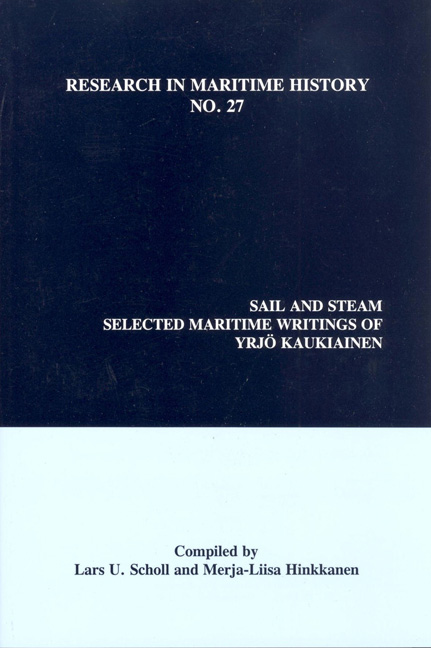Book contents
- Frontmatter
- Frontispiece
- Table of Contents
- Acknowledgements
- “Yrjö Kaukiainen: A Tribute on the Occasion of his Forthcoming Retirement as Professor of Maritime History at the University of Helsinki”
- “Yrjö Kaukiainen: A Man of the Sea”
- “Yrjö Kaukiainen and the Development of Maritime Economic History”
- “Finnish Sailors, 1750-1870”
- “Finnish and International Maritime Labour in the Age of Sail: Was There a Market?”
- “Five Years before the Mast: Observations on the Conditions of Maritime Labour in Finland and Elsewhere”
- “The Maritime Labour Market: Skill and Experience as Factors of Demand and Supply”
- “Owners and Masters: Management and Managerial Skills in the Finnish Ocean-Going Merchant Fleet, c. 1840-1880”
- “From Low-Cost to High-Cost Shipping: Finnish Maritime Labour Costs after the Second World War”
- “The Modernization of Finnish Coastal Shipping and Railway Competition c. 1830-1913”
- “British Timber Imports and Finnish Shipping 1860-1910”
- “Baltic Timber-Trade under Sail: An Example of the Persistence of Old Techniques”
- “Coal and Canvas: Aspects of the Competition between Steam and Sail, c. 1870-1914”
- “Dutch Shipping and the Swedish Navigation Act (1724). A Case Study”
- “Seamen Ashore: Port Visits of Late Nineteenth-Century Finnish Sailors”
- “Wreck-plundering by East Finnish Coastal People - Criminal Tradition or Popular Culture?”
- “From Days and Knots to Pounds and Dollars: Some Problems in the Study of the Economics of Late Nineteenth Century Merchant Shipping”
- “Tons and Tonnages: Ship Measurement and Shipping Statistics, c. 1870-1980”
- “International Freight Markets in the 1830s and 1840s: The Experience of a Major Finnish Shipowner”
- “Shrinking the World: Improvements in the Speed of Information Transmission, c. 1820-1870”
- “Yrjö Kaukiainen: A Maritime Bibliography”
“Five Years before the Mast: Observations on the Conditions of Maritime Labour in Finland and Elsewhere”
- Frontmatter
- Frontispiece
- Table of Contents
- Acknowledgements
- “Yrjö Kaukiainen: A Tribute on the Occasion of his Forthcoming Retirement as Professor of Maritime History at the University of Helsinki”
- “Yrjö Kaukiainen: A Man of the Sea”
- “Yrjö Kaukiainen and the Development of Maritime Economic History”
- “Finnish Sailors, 1750-1870”
- “Finnish and International Maritime Labour in the Age of Sail: Was There a Market?”
- “Five Years before the Mast: Observations on the Conditions of Maritime Labour in Finland and Elsewhere”
- “The Maritime Labour Market: Skill and Experience as Factors of Demand and Supply”
- “Owners and Masters: Management and Managerial Skills in the Finnish Ocean-Going Merchant Fleet, c. 1840-1880”
- “From Low-Cost to High-Cost Shipping: Finnish Maritime Labour Costs after the Second World War”
- “The Modernization of Finnish Coastal Shipping and Railway Competition c. 1830-1913”
- “British Timber Imports and Finnish Shipping 1860-1910”
- “Baltic Timber-Trade under Sail: An Example of the Persistence of Old Techniques”
- “Coal and Canvas: Aspects of the Competition between Steam and Sail, c. 1870-1914”
- “Dutch Shipping and the Swedish Navigation Act (1724). A Case Study”
- “Seamen Ashore: Port Visits of Late Nineteenth-Century Finnish Sailors”
- “Wreck-plundering by East Finnish Coastal People - Criminal Tradition or Popular Culture?”
- “From Days and Knots to Pounds and Dollars: Some Problems in the Study of the Economics of Late Nineteenth Century Merchant Shipping”
- “Tons and Tonnages: Ship Measurement and Shipping Statistics, c. 1870-1980”
- “International Freight Markets in the 1830s and 1840s: The Experience of a Major Finnish Shipowner”
- “Shrinking the World: Improvements in the Speed of Information Transmission, c. 1820-1870”
- “Yrjö Kaukiainen: A Maritime Bibliography”
Summary
The grim living conditions of ordinary sailors, and the despotic discipline to which they were subjected, were integral parts of the Western maritime past. These unpleasant realities came to wide public notice for the first time in 1840 when Richard Henry Dana published his famous Two Years before the Mast. This book, which was followed by other more or less authentic descriptions, inaugurated a literary tradition that later included writers such as Herman Melville and Jack London. Although such books only seldom embodied true “voices from the forecastle,” they still comprise an extremely valuable stock of knowledge on which many scholars have relied. Recently, however, authentic documentary sources increasingly have been exploited to gain an even more accurate comprehension of living conditions before the mast.
Although the cruelty of maritime discipline sometimes closely resembled some of the features of slavery, it was not not always this way. Medieval maritime codes, such as the well-known Rôles d'Oleron, did not vest all power in the master; on the contrary, collégial rather than hierarchical relations were most typical. Common sailors had the right to express their opinions on important decisions and often their consent was required before the master could act. In coasting, deep-sea fishing and other traditional maritime trades egalitarianism and patriarchal rather than despotic discipline prevailed. It thus seems that masters with absolute power prepared to exercise “naval” discipline were a product of the early modern period, and that they only became the norm after a fairly protracted process of diffusion.
Marcus Rediker contended that the new system was quite fully developed at the end of the seventeenth century. Eric W. Sager, on the other hand, seems to believe that in Canada the transition occurred during the early nineteenth century (although he connected it with industrialization). It is certainly reasonable to presume that it may have started at the centre of the early modern maritime world and spread only gradually to more peripheral countries. Thus far, however, there seems little real evidence, apart from some general statements in older textbooks, on the origins of the new system, nor is it clear how uniform it was - in fact, it is difficult even to define its elements.
- Type
- Chapter
- Information
- Sail and SteamSelected Maritime Writings of Yrjö Kaukiainen, pp. 31 - 44Publisher: Liverpool University PressPrint publication year: 2004



